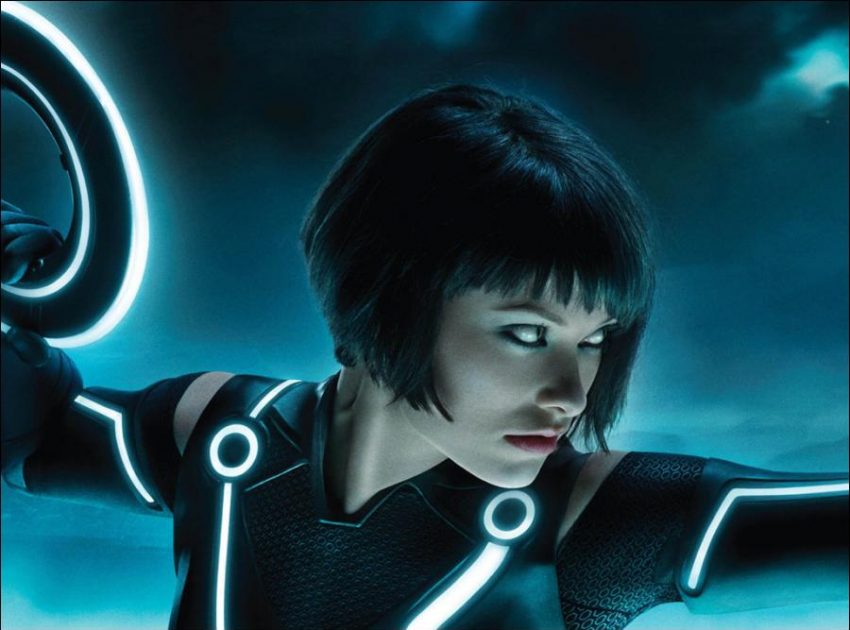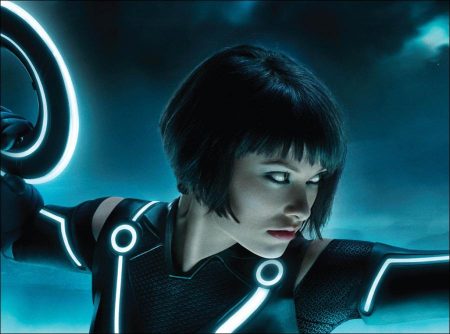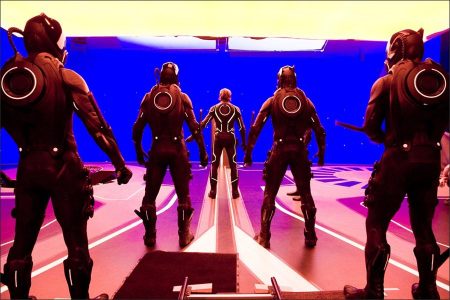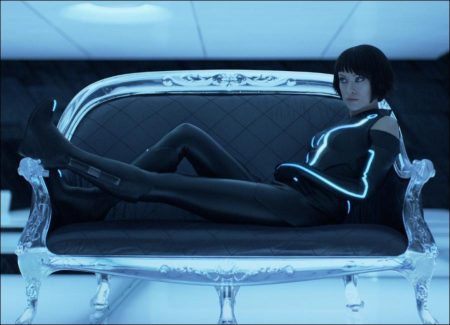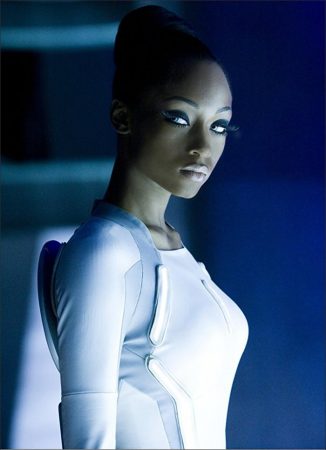The Evolution of the Story
In 1982, when Kevin Flynn (Jeff Bridges) made it out of the Grid alive and back in control of Encom, the company he founded with his longtime friend and associate, Alan Bradley (Bruce Boxleitner), everyone assumed Kevin would be content with developing and producing popular games.
On the surface of things, that appeared so: Kevin married, had a son, Sam, and settled into fatherhood while he and Alan grew Encom into a video game powerhouse. But unbeknownst to outsiders, Kevin was still experimenting with teleportation, making frequent visits back to the Grid from the privacy of his secret lab hidden beneath Flynn’s Arcade. Then one day Kevin simply vanished, and Sam was left alone with no father and no answers.
And twenty years later, “TRON: Legacy” begins. When a pager signal draws the now-adult Sam (Garrett Hedlund) to Flynn’s Arcade and he is transported to the Grid where his father has been trapped for 20 years, he begins a journey that will change his life—and the life of his long-absent father.
“It was very important to us, amidst all this visual spectacle, to focus on a father/son story; this is about a boy who’s lost his dad, who’s now grown up and, as a man, he has scarring from that. Then, he learns that his father’s disappearance may not have been all that he thought, and there’s a chance for them to rebuild their relationship,” says producer Sean Bailey. “Our goal is to make sure we’re serving our story the best way we can. And the visuals, the effects, the music, the performances and the style all support that,” he adds.
The estrangement and rediscovery between father and son is the story’s emotional entry point. “You’re coming into this spectacular domain and you need someone to experience it through. That’s how we approached developing Sam’s character. You’re discovering the Grid through Sam’s eyes, and you’ll also discover Flynn through Sam,” says Adam Horowitz, who co-wrote the screenplay with Edward Kitsis (story by Edward Kitsis & Adam Horowitz and Brian Klugman & Lee Sternthal, based on characters by Steven Lisberger and Bonnie MacBird).
Steven Lisberger feels that it is important to have a story that is as significant as all the technical aspects that go into the film. “I care about story and characters as much as I do the visuals. The story aspect of Flynn still being alive and the father-son story is really compelling in ‘TRON: Legacy.’ It will resonate with the fan base, but if someone hasn’t seen the first film, it doesn’t matter—the story will work for him or her too,” he says.
Jeff Bridges, who reprises his role of Kevin Flynn from the original “TRON,” comments, “One of the underlying elements of the story is technology. It’s so exciting to realize all the things that you can do. But what’s happening with technology is that it is developing so fast that we haven’t really developed any ethics to go along with it, or knowledge of what some of the ramifications of this technology will be. So that’s also a theme that ‘TRON: Legacy’ deals with.”
The Making of Tron: Legacy
Joseph Kosinski is very clear in defining his approach to the making of “TRON: Legacy”: “My goal was to really make it feel real. I wanted it to feel like we took motion picture cameras into the world of TRON and shot it. So I wanted to build as many sets as possible. I wanted the materials to be real materials: glass, concrete, steel, so it had this kind of visceral quality to it.”
To achieve the exciting, iconic look for “TRON: Legacy,” Kosinski gathered around him artists from diverse disciplines. “We pulled people from the world of architecture, from automotive design, people who have never worked in movies before. We flew people in from all over the world,” says Kosinski.
Kosinski and his team knew they would be pushing the boundaries of what current effects technology can achieve to make “Legacy” in the spirit of “TRON.” The result is a complicated blend of techniques, from blue screen to 3D cameras, that Kosinski and his team have melded together for the film. Kosinski explains, “I’m going more on instinct rather than experience, but a lot of the technology we’re using is stuff I’ve used bits and pieces of in commercials. However, this is the first time we’re using it simultaneously at this scale.”
According to Bailey, though, the driving force is still the plot. “We took every technology at its most cutting edge at the moment in time, but I always think it’s not just technology for technology’s sake, but as we do some twists in the movie, it enables us to write in a whole new way. I think we will be the first movie that has an actor squaring off against himself in two very different generations. I hope we will surprise the audience not just in an, ‘oh that’s a cool, glorious effect’ way, but also in an, ‘oh I never saw that coming’ way.”
In addition to the technological complexities of “TRON: Legacy,” it is also produced in 3D. As Bailey comments, “3D is definitely a challenge technically; the cameras are bigger and heavier and there are a lot of extra variables that you have to take into account, so it definitely slows the process down. But I think it’s a great reason to go to the movies because it’s an experience that you just can’t recreate on an iPhone or your laptop or at home.”
“It was important for me that this be a true 3D movie,” says Kosinski. “There are a lot of movies out there right now that are being converted from 2D after the fact. But with the environments we’ve created—the fact that we’re trying to get atmosphere and these long, distant vistas—we just can’t do it any other way than shoot it with real 3D cameras.” Kosinski continues, “It is a lot more work to shoot in 3D; the VFX are being finished in 3D, which is also a challenge. Having to create separate imagery for both eyes makes it that much more work.”
For shooting “TRON: Legacy” in 3D, the filmmakers employed the newest generation of camera, built specifically for them, and used a 3D technique that is a combination of technologies—completely digital motion-capture of a character and the live-action camera system.
The Look of Tron: Legacy
The filmmakers and designers of “TRON: Legacy” let their creativity soar to develop an exciting aesthetic for the film that would immerse audiences in a stunning visual landscape never before seen—or imagined. With director Joseph Kosinski at the helm to steer the film’s look and Darren Gilford tapped as production designer, it was clear to both of them that keeping the first film’s spirit alive was key. “The first film established a look that was so iconic,” Gilford explains, “and a lot of that was because of the limitations of the computer, what they really could do back in the ’80s. It was very geometric, very simplistic. With the computer technology we have now, it’s limitless what we can do. But we made a conscious decision that we would not go totally organic. We’d soften shapes and forms where we could, but we would definitely try and maintain those basic ‘TRON’ geometric shapes.”
To accomplish this, heavyweight talents were required, including concept artist David Levy. It was his job to convert Kosinski’s ideas to drawings and designs and establish the new film as its own world. “Joe’s vision evolved the visuals from the first film. He wanted the Grid to feel exactly like our reality, but with a twist,” Levy says.
Kosinski’s aim was to blend the real and the unreal without anyone noticing. “I don’t want the audience to know where the line rests, so sometimes I’m going to shoot everything completely practical, and then sometimes, it will be one practical set piece surrounded by blue screen. And if we do it right, it should be unnoticeable; it should be seamless,” says Kosinski.
In this respect, “TRON: Legacy” strays far away from the original. “The marriage of photorealistic computer-generated images and actual practical sets really gives you a sense of the world that you’re in,” says Jeff Bridges. “In the original ‘TRON’ we didn’t have that because it was basically black duvetyn with white adhesive tape marking things; we never got the feeling of where we actually were. There’s nothing like walking onto the set for the first time and seeing it all dressed.” Thus, with Kosinski’s set-creation mantra in place and his control of the production design, “TRON: Legacy” does not become an entirely CGI movie. Vancouver’s spectacular new Shangri-La Hotel doubled as Encom, and Sam’s shipping container apartment was built on a wharf across the inlet from Vancouver to make best use of a stunning view of the city’s skyline. Other sets, including Flynn’s Arcade, Kevin’s safe house, and the End of Line Club were built on one of six sound stages.
Whole streets on the grid were built here, too, on a scale greater than that of most real city streets. “When Sam first walks out of the arcade onto the Grid,” says production designer Darren Gilford, “a Recognizer comes down and plucks him off the street. So the Recognizer defines the size of the city street, and a Recognizer is about seventy feet wide. From that proportion alone we knew the minimal amount of city we needed, which was about two city blocks. It was a huge, huge build.”
Twenty to 25 designers in various art departments churned out concepts and from those, Kosinski and his team created the sets—from real-world locations, mixtures of real architecture with blue screen, to fully digital sets. Gilford estimates that there are between 60 and 70 unique settings in the film, split between 15 impressive fully constructed sets and varying levels of computer-created landscapes. The special challenge was creating the look of the Grid. Kosinski explains: “Every film requires location scouting and sets. With my background in design I realized that especially for a film like this where everything has to be designed, I needed to be paying attention to the design of the spaces. Because there is no location we can go and shoot a scene for this movie. Every single shot in the TRON digital world had to be built from scratch.”
While a lot of production took place on soundstages in Vancouver, the filmmakers decided to ease into shooting with some shots on location in the city itself—a goal easier said than done. Bailey says, “We knew moving into the TRON grid, we would be tackling three to five unprecedented technologies in concert, which we knew would be really hard. So, for the crew to get their feet, we thought, ‘Let’s knock out a couple of weeks in the real world.’ The real-world shooting turned out to be anything but small— it was shooting guys on top of the tallest building and involved shutting down the biggest street in the city.”
Finally, since “TRON: Legacy” will be released in 3D, filmmakers were confronted with a unilateral challenge, one which would influence every decision made on the visual aspects of the film. Production designer Gilford says, “There are certain aspects that we had to design around and certain rules we had to obey. For example, when moving the 3D camera rig, one camera could reveal a light source a split second before the other. It can be a nightmare.”
Much care and foresight was also taken in the production design to incorporate iconic images from the mythology of “TRON.” For example, the art department incorporated many of the original film’s images and props into Flynn’s secret lab beneath the arcade. Those with a sharp eye will recognize the Master Control Program desk caddy from the original film, the tabletop computer interface and a condensed version of the Shiva laser, which takes Sam into the Grid. Others will make out a map of the Grid embedded in the code of the background image and Sam’s drawings from childhood on the wall.
Grid Lifestyle
The most important unifying element in the Grid is light. “In our film light links everything together. There are ribbons of light that form beneath the street then crawl up sidewalks and buildings, continuing for miles up into the city,” comments production designer Gilford. “Streetlights arise out of and wrap over the street to give the illusion they’re cradling the street.”
At the End of Line Club at the top of the Grid’s mile-high skyscraper, light is embedded in almost every surface: ribbons of light wrap around the floor and ceiling and around the booths. Even the drinks are illuminated. And the club’s roof and walls are glass, offering a view of the city lights and the beacon of the distant portal.
But the element of light is perhaps best identified in the lit suits, which were a challenge to construct. Lead concept artist Neville Page and director Kosinski believed the suits they conceived could be made and shot “practical,” that is, without the use of CGI—so the designers went to work to make them a reality.
In the end the lighted suits were created by using electroluminescent lamps made from a flexible polymer film. Most of the form-fitting suits were made out of foam latex, but the Sirens’ suits were made by spraying balloon rubber over spandex, giving an incredible, supersleek shape. The actors wearing those suits had to be severely compressed within the suits to compensate for the bulk of the electronics.
“In addition to the main cast costumes,” adds Christine Bieselin Clark, who worked with the film’s costume designer Michael Wilkinson, “we also built all of our background costumes. Once you go into the Grid, everybody has some element of light. We ended up making over 140 foam suits, which there is no precedent for.”
The body-molded suits with their distinct lighting patterns are influencing clothes and shoe designers, with “TRON: Legacy” fashion elements showing up on runways and in fashion magazines. The distinctive hairstyles, such as upswept hair, and the bold eye-makeup treatments are setting new style trends around the world.
Costume Facts
Programs loyal to Clu wear black suits lighted with oranges and reds—the colors of Clu’s domain. Clu is the only one lighted with yellow—a sign of his supremacy. The colors of the Grid-dwellers are the cool whites, blues and silver.
Because donning the suits was a time-consuming and labor-intensive process, special inversion boards were provided to allow actors to get off of their feet and recline without endangering the costume.
It took a team of hair and makeup artists—along with two dressers for each “suiting”—about three hours to transform the actresses into the mysterious Sirens.
The helmets worn by the actors were especially designed by the costume designers to coordinate with the characters and the look of “TRON: Legacy”—no stock helmets were used.
“It is an amazing landscape. It’s expanded, it’s grown; it’s darker, more sophisticated. But also it has developed free of the Internet. This is not a movie about the Web. This is a world that has grown almost like the Galapagos Islands on a server, and become something very potent and unique.” — Sean Bailey, producer
The architecture of “TRON: Legacy” features minimalist interiors and modern, light-enhancing building angles with extensive use of architectural under-lighting and lighted floor track lines. In Kevin Flynn’s safe house, neo-Victorian furniture is featured in the minimalist interior, creating a look that blends the old with the new.
Given his architectural background, it’s no surprise that director Joseph Kosinski admits Flynn’s safe house is his favorite set on the movie. “It’s just a gorgeous set. It was one that I actually just sketched on a scrap of paper as a look when we were doing the VFX test before the movie even started. The idea is that Kevin Flynn is trapped in the world of computers, so he’s tried to create a space that has hints of the real world. The furniture, the food, just the feel is like something only a human being in a digital grid would try to create in order to make themselves feel as comfortable as possible.”
Grid-dwellers entertain themselves with gladiator-like games, where combatants square off against each other with light discs and batons, and enjoy watching deadly Lightcycle races in huge stadiums with multilevel tracks. The games are an important part of the Grid-dwellers’ lives and their principal form of entertainment in the boundary-defined digital grid. Kosinski and his design teams worked to bring the games and races to a whole new dimension…literally. “We wanted to evolve these games by taking them off a two-dimensional plane and moving them into three dimensions, so you end up with a three-dimensional chess game in terms of choreography. For instance, in the Lightcycle match we’ve got ten Lightcycles going simultaneously on a multilevel grid,” explains Kosinski.
As long as they are on the Grid the programs are enhanced and surrounded by light, whether they are walking on the city streets, viewing the games, or relaxing at the End of Line Club—but off the Grid in the Outlands, only darkness and treacherous terrain await.
Tron: Legacy (2010)
Directed by: Joseph Kosinski
Starring: Jeff Bridges, Garrett Hedlund, Olivia Wilde, Bruce Boxleitner, James Frain, Serinda Swan, Elizabeth Mathis, Conrad Coates, Ron Selmour, Daft Punk, Darren Dolynski
Screenplay by: Edward Kitsis, Adam Horowitz, Brian Klugman
Production Design by: Darren Gilford
Cinematography by: Claudio Miranda
Film Editing by: James Haygood
Costume Design by: Christine Bieselin Clark, Michael Wilkinson
Set Decoration by: Lin MacDonald, Gena Vazquez
Music by: Daft Punk
MPAA Rating: PG for sequences of sci-fi action violence and brief mild language.
Distributed by: Buena Vista Pictres
Release Date: December 17, 2010
